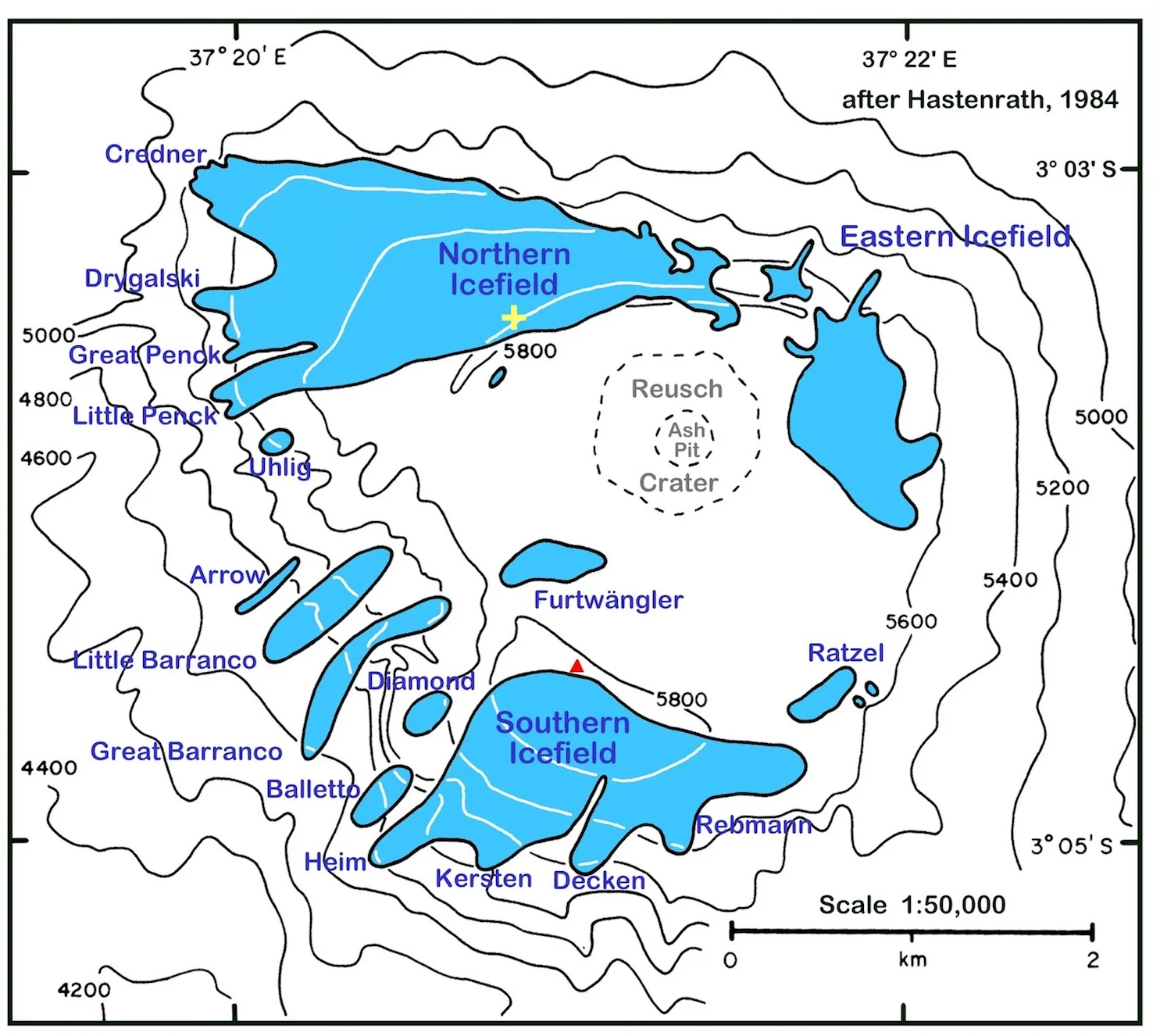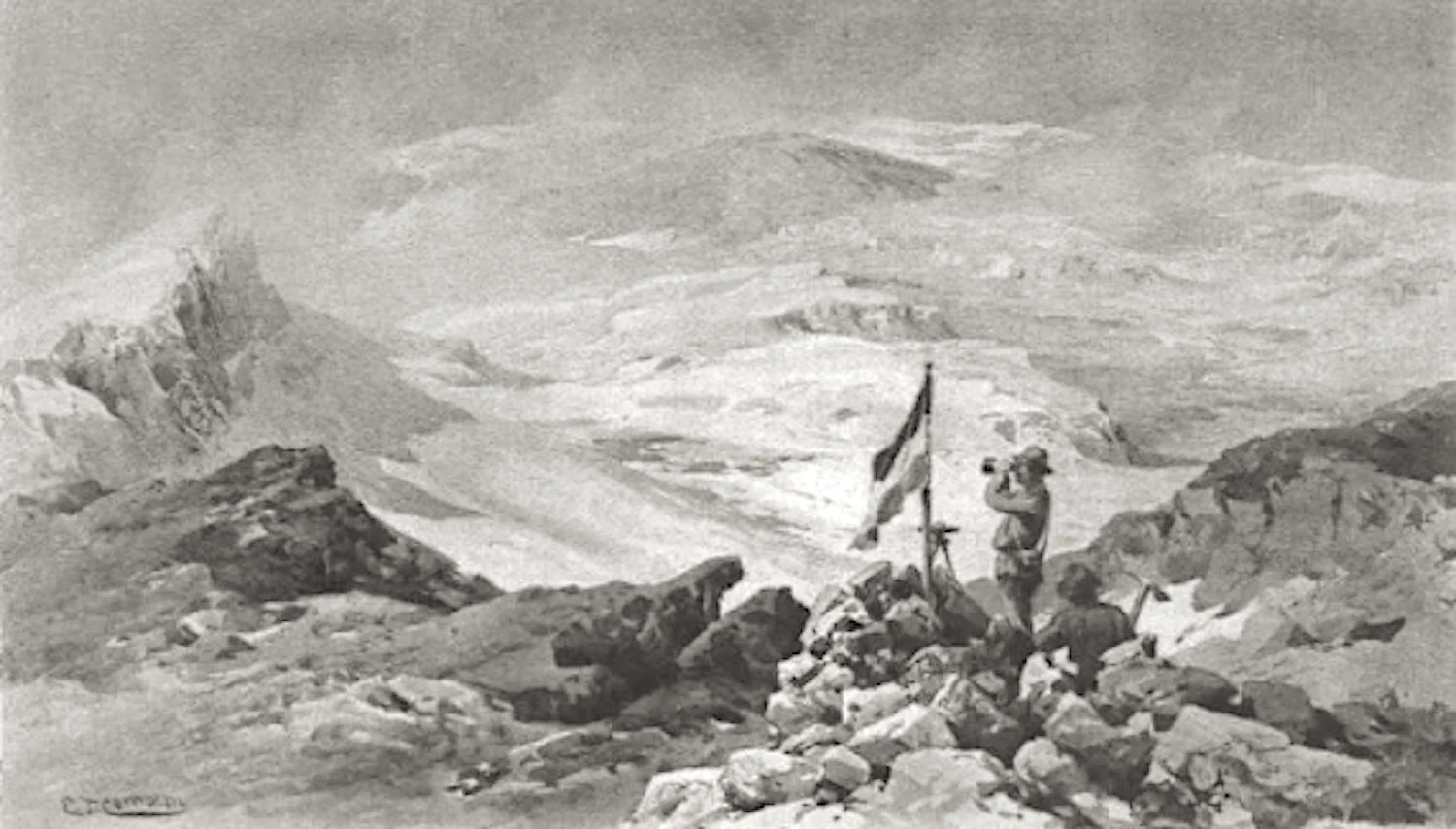Great sheets of ice flanked our walk on Kibo's rim. Aside from the fact that we were tripping along a corridor that was 19,000 feet in the sky, it could have been someone's gravel driveway. Or one of Jupiter's moons.
Our path followed the upper edge of the Southern Icefield (The red triangle below marks our goal, Uhuru Peak.).
Kibo ice, after Hastenrath, 1984 (Map 4.1:1). Based upon data collected in the mid-1970s. This graphic was accessed here on 1/1/18).
I squinted at the Southern Ice Field. Its scale was difficult to appreciate in the dim light of the sunrise. The frozen slab rose up like a wall, trailed downslope for a short distance, then abruptly disappeared into dark air. It plunged downward for more than a thousand feet. On the shattered upslope side where I stood, horizontal layering was visible along a vertical face that was at least a hundred feet high. I gaped at the sight, not unlike how one ponders an endangered species in the zoo. It was among the last of its kind.
The broken edge of the Southern Ice Field rose up like a wall. The scale in this photograph is deceptive.
The Southern Ice Field is a fragile remnant of a cap that once covered Kibo's head. "Ice Hunter" Lonnie Thompson, an Ohio State professor and a leading researcher in the study of glacial dynamics, suggests that it is 11,700 years old in places,* a claim that gets traction with this dirt archaeologist. It also reminds me that our notion of "stratification" was taken straight off the page of the geologist.
If Thompson is right, the snow that started this "bulk up" drifted out of the sky long before the pyramids of Egypt were built and even before the columns of Göbekli Tepe were hoisted into place. These ice layers are an invaluable ecofact of the past. They offer "a nearly continuous, high-resolution record of Holocene climate conditions."** What makes the glaciers of Kilimanjaro even more unique is that their accumulated sequence was formed in earth's tropical zone. Corroborative evidence is rare.***
An idealized cross-section of a glacier showing areas of accumulation and ablation. The one missing aspect in the drawing is sublimation, the process by which ice turns to water vapor without passing through the liquid stage. Sublimation is the means behind the mystery of the disappearing glaciers of Kilimanjaro. Image from here (accessed 2/12/2018).
Data derived from this ice has been batted about by those who debate global warming. Regardless of one's position in the fuss, three things seem certain.
First, the ice cap is in full retreat and has been for as long as anyone can remember. Photographs taken over the course of the last century conclusively demonstrate this (consider the image here). Since 1912, the cap has shrunk by 80%.** However explained (deforestation, global warming, decreased moisture, etc.), the forecast is dire. Our generation may be the last to witness the mountain with a white crown. In the future the "the snows of Kilimanjaro" may be little more than a literary exercise. Hemingway would have obscenely well obscenitied himself.
Image from 1950 labeled "East Africa - Mt. Kilimanjaro Crater. Eternal Ice on the Equator." Unfortunately this ice is not as eternal as once believed. Image from here.
Second, at noted above, evidence suggests that Kilimanjaro's ice cap began forming at the tail-end of what my homies would call the Epipaleolithic period (20,000-10,500 years BP). Around this same time (give or take a woolly mammoth sneeze), the last "ice age" to grip the northern hemisphere was releasing. Put more simply, ice began to grow on this mountain as it was in full retreat elsewhere. This odd juxtaposition demands attention. I may be walking on thin ice here (did you see that?), but it seems that climate drivers in the temperate zones work differently than climate drivers in the tropics.
Third, layers of disappearing ice on Kilimanjaro preserve valuable clues about the past. The urgency to retrieve that evidence has never been higher. Samples taken by Thompson and company demonstrate three periods of abrupt climate change: the first about 6,300 BC, the second about 3,200 BC, and the third, about 2,000 BC. The last of these (and the most visible of the group due to a thick dust layer) aligns with the shifting fortunes in the Near East between the Early and Middle Bronze Ages. Scholars have long believed that the catastrophic end of the Early Bronze Age was related in some way to changing climate. Finding the fingerprints of a 300-year drought on what is left of this frosty pane is intriguing to this Ancient Near Easter.**
Drawing of the Kilimanjaro's crater published in Hans Meyer's publication, Der Kibo-Krater des Kilimandscharo (1890). Image available here.
*See the release of Lonnie Thompson and his colleagues, "African Ice Core Analysis Reveals Catastrophic Droughts, Shrinking Ice Fields, Civilization Shifts" in Science News, October 18, 2002. The release is available here (accessed 2/11/2018).
**Lonnie Thompson et al., "Kilimanjaro Ice Core Record: Evidence of Holocene Climate Change in Tropical Africa." Science 298 (Oct 18, 2002): 589-593. Accessed online on Feb 14, 2018.
***For the sake of comparison, consider that long ice cores from Antarctica (where one would expect to find ancient ice) go back 800,000 years in time. See Laetitia Loulergue, et al. "Orbital and millennial-scale features of atmospheric CH4 over the past 800,000 years." Nature 453 (2008): 383–386. Here is a link to the article.
Hans Meyer is depicted in this image titled, "Der krater des Kibo." Illustration from an online edition of Across East African Glaciers: An Account of the First Ascent of Kilimanjaro (George Philip & Son, 1891). Accessed here on 2/14/18.
For more about Kilimanjaro's ice, see
Mote, P.W., Kaser, G. "The Shrinking Glaciers of Kilimanjaro: Can Global Warming be Blamed?" American Scientist 95/4 (2007): 318-325.
Raymond Pierrehumbert, "Tropical Glacier Retreat." Editorial published 23 May 2005 on RealClimate.org. The text to this article is available here (accessed February 13, 2018).






